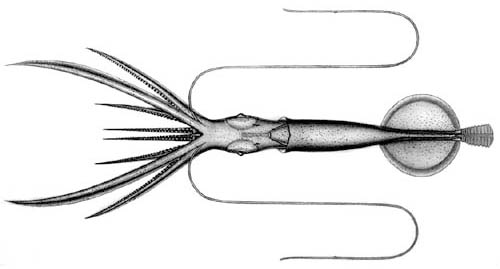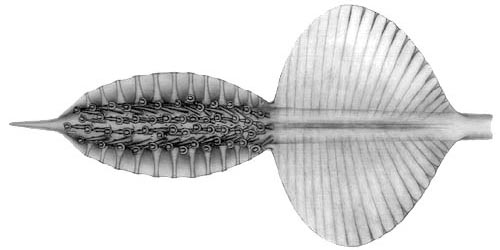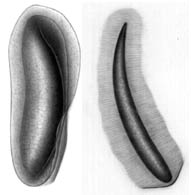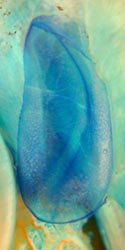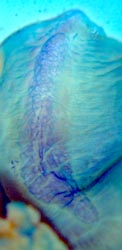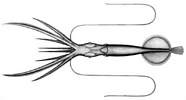Asperoteuthis sp. A
Richard E. Young, Michael Vecchione, and Clyde F. E. RoperIntroduction
Asperoteuthis sp. A is very gelatinous, with about the same consistency as Grimalditeuthis bonplandi. It has elongate ventral arms in small squid, but these get relatively short in large squid. It lacks the tubercles and elongate fins of A. acanthoderma.
Diagnosis
An Asperoteuthis ...- without integumental tubercules.
- with comma-shaped groove in funnel locking-apparatus.
Characteristics
- Arms
- Largest arm suckers with 6-10 truncated teeth on distal half of ring.
- Tentacles
- Suckers with ca. 8 large, truncated teeth on distal half of inner ring grading to ca. 17 small, truncated teeth on proximal half.
-
Club with very broad proximal protective membrane and long terminal papilla.
Figure. Oral view of tentacular club of Asperoteuthis sp. A, NMNH 729749, holotype. Drawing by A. Hart.
- Funnel
- funnel-locking apparatus oval with a rounded ridge in the midline (tragus?) and an elongate, deep, curving groove laterally; mantle locking component with matching curved ridge. Antitragus absent.
Figure. Frontal views of the funnel-mantle locking apparatus of Asperoteuthis sp. A. . Left - Funnel (left) and mantle (right) components, NMNH 729752. Drawings by A. Hart. Right - Funnel (left) and mantle (right) components, 100 mm ML, mature male, paratype, stained with methylene blue. Photographs by R. Young.
- funnel-locking apparatus oval with a rounded ridge in the midline (tragus?) and an elongate, deep, curving groove laterally; mantle locking component with matching curved ridge. Antitragus absent.
- Mantle
- Mantle and other integument without tubercles.
- Fins
- Fin length 40% of ML.
- Fin width approximately equals fin length.
- Photophores
- Club-tip photophore small, terminal papilla large.
- Small embedded photophores present on aboral surface of club.
- Ventral eyeball photophore present.
- Luminescent pads present on tentacle stalks.
Comments
More details of the description can be found here.
Asperoteuthis sp. A apparently possesses a large secondary tail but a specimen with an attached tail has not been captured.
 image info
image info
Figure. The drawing is a reconstruction based on the collection of a damaged tail in the same tow with a small (80 mm ML) Asperoteuthis sp.A. The tail did not match the broken end of the gladius from the specimen indicating that a piece of the tail was missing. Tentacular clubs missing from specimen, added to drawing. Drawing by A. Hart.
 image info
image info
Figure. The photograph shows the tail of a large Asperoteuthis from the same locality and possibly belonging to a large Asperoteuthis sp. A although the shape differs greatly from that of the small specimen above.
Very few Asperoteuthis sp A have been captured with the clubs attached as the long, thin tentacles are easily broken off during capture. With tentacles missing, it can be confused with Grimalditeuthis bomplandi in its general shape and consistency. However, many differences easily separate them including presence of the funnel-mantle fusion and three large papillae on each arm-sucker base in G. bomplandi.
In addition to the features listed in the Diagnosis, Asperoteuthis sp. A differs from A. acanthoderma in (1) the weaker consistency of the arms and mantle, (2) the dentition of the arm (6-10 vs 3-4) and club (25 vs 9 teeth) suckers, (3) the smaller and more circular terminal club photophore, (4) the longer terminal papilla on the club and (5) the broader fins (width ca 115% of length vs ca 75% of length). In addition, the club suckers of A. acanthoderma are on shorter stalks, the sucker rings are more elongated in the oral-aboal directiion and suckers of arms IV are more densely packed.
Distribution
Vertical distribution
Off Hawaii eight specimens were captured during a study to examine the vertical distribution of cephalopods. All specimens were captured during the day at depths between 775 and 975 m. The absence of captures in the heavily sampled waters from 0-400m depth at night suggests that this species is not a vertical migrator.
Figure. Vertical distribution chart of Asperoteuthis sp. A. Captures were made with both open and opening/closing trawls. Bars - fishing depth-range of opening/closing trawl. Circle - Modal fishing depth for either trawl. Yellow-filled circles - Day capture.
Geographical distribution
Type locality: Hawaiian waters at 21°25'N, 158°20.5'W. The holotype was captured in an opening-closing trawl between 820 and 870 m depth during the day (1411-1616 hrs). This species is known only from the waters off the Hawaiian Islands. Both Asperoteuthis sp. A and Asperoteuthis acanthoderma occur in these waters but Asperoteuthis. sp. A is much more abundant.
References
Young, R. E. 1978. Vertical distribution and photosensitive vesicles of pelagic cephalopods from Hawaiian waters. Fish. Bull., 76: 583-615.
About This Page
Richard E. Young
Dept of Oceanography
University of Hawaii
Honolulu, Hawaii 96822
USA
National Marine Fisheries Service
Systematics Laboratory
National Museum of Natural History
Washington, D. C. 20560
USA
Page copyright © 1999 Richard E. Young, , and
Citing this page:
Young, Richard E., Vecchione, Michael, and Roper, Clyde F. E. 1999. Asperoteuthis sp. A . Version 01 January 1999 (under construction). http://tolweb.org/Asperoteuthis_sp._A/19467/1999.01.01 in The Tree of Life Web Project, http://tolweb.org/





